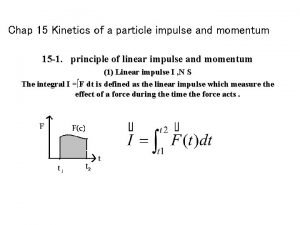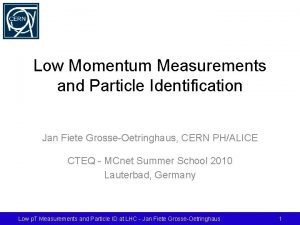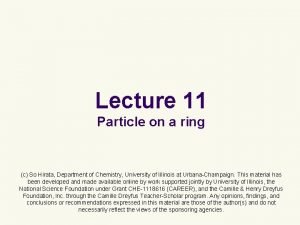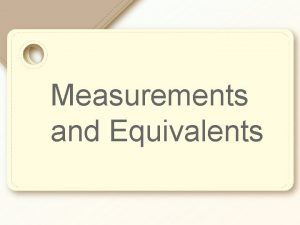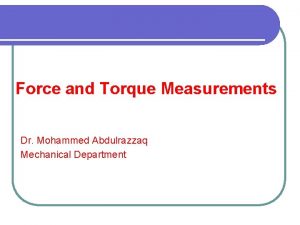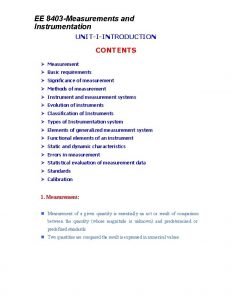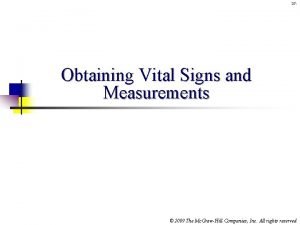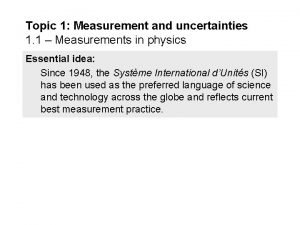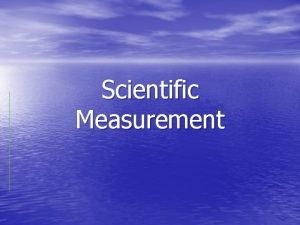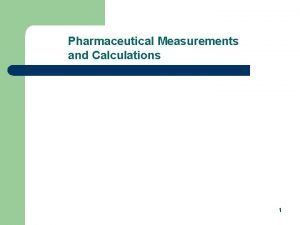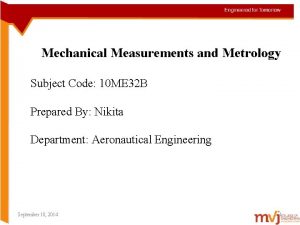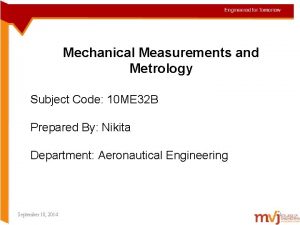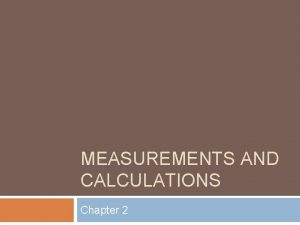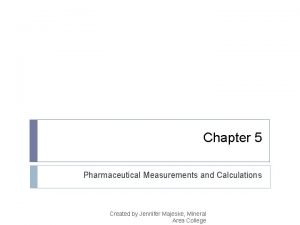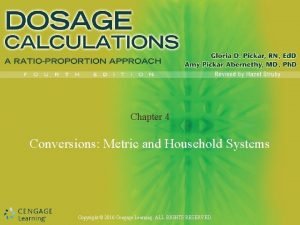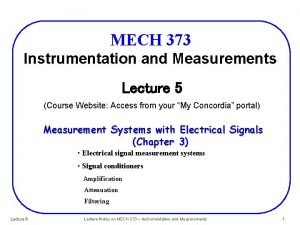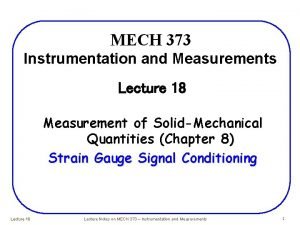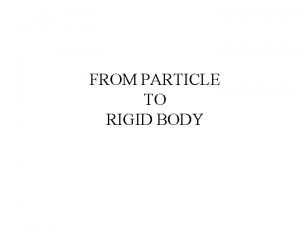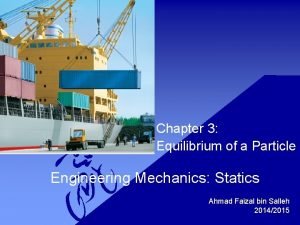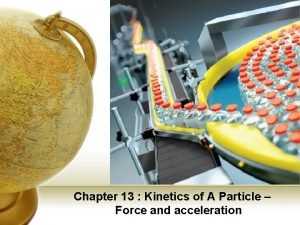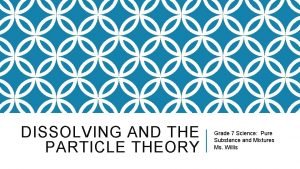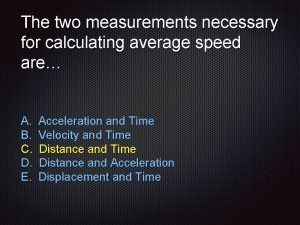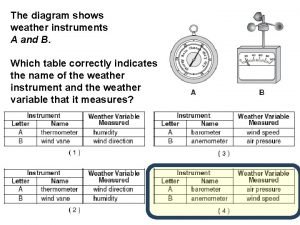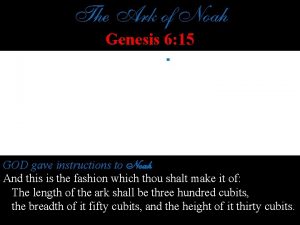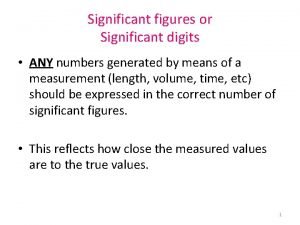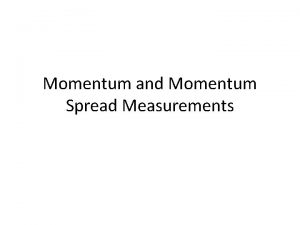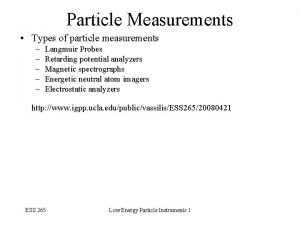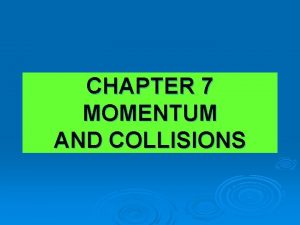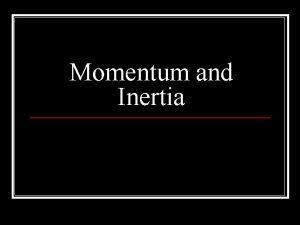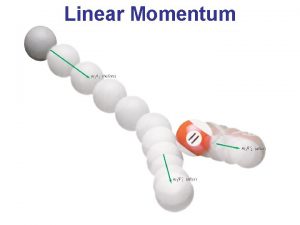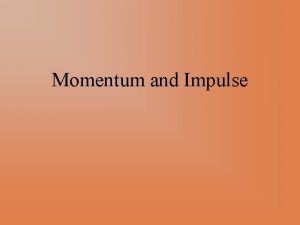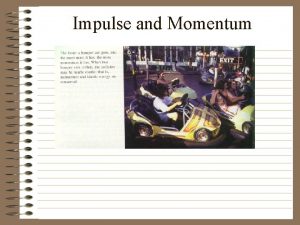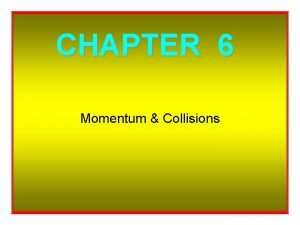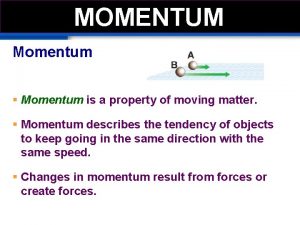Low Momentum Measurements and Particle Identification Jan Fiete












































- Slides: 44

Low Momentum Measurements and Particle Identification Jan Fiete Grosse-Oetringhaus, CERN PH/ALICE CTEQ - MCnet Summer School 2010 Lauterbad, Germany Low p. T Measurements and Particle ID at LHC - Jan Fiete Grosse-Oetringhaus 1

Content • Methods – Low p. T tracking – Particle identification (PID) • Capabilities at the LHC experiments – ALICE, ATLAS, CMS, LHCb • Physics Results – Analysis Methods – Comparisons to Monte Carlos Low p. T Measurements and Particle ID at LHC - Jan Fiete Grosse-Oetringhaus 2

Count Motivation |h| < 2 7 Te. V Pythia D 6 T • Low momentum measurements – Especially at low p MC generators depend on phenomenological QCD-inspired models • Low p production in soft (small Q 2) regime • p. QCD cannot be applied p. T (Ge. V/c) – The underlying event is mostly soft • Need to understand especially low p. T to assess background right • Particle identification – Reconstruction of masses of well-known resonances assess performance of tracking – Input for the description of fragmentation (strangeness) – Hadrochemistry (statistical model) allows to extract freeze-out temperatures and baryochemical potential in heavy-ion collisions (pp needed as baseline) 7 Te. V, Pythia D 6 T p. T (Ge. V/c) 0. 05 0. 15 0. 2 0. 5 0. 75 1. 0 Particles below 0. 2% 1% 3% 7% 40% 63% 76% Low p. T Measurements and Particle ID at LHC - Jan Fiete Grosse-Oetringhaus 3

Low Momentum Tracking • LHC detectors are operated with magnetic field – Particles with low momentum have a small bending radius might not reach outer parts of detector – Multiple Coulomb interaction scattering results in wider distribution at low p. T (q ~ (bp)-1) hits in the detector might not be associated to the same track • Detector components close to the beam line are used for low momentum tracking – Silicon detectors in all LHC experiments Low p. T Measurements and Particle ID at LHC - Jan Fiete Grosse-Oetringhaus 4

• Single cluster measurement – Difficult to associate particles with primary vertex – Cluster shape can be used to separate primaries and secondaries Pixel cluster z length Low Momentum Tracking Approaches CMS, JHEP 02 (2010) 041 h • Tracklets – Uses at least two layers – Straight line fits • Tracks – At least 3 -4 layers – Primary vertex constraint – Magnetic field taken into account Layer 1 Layer 2 Low p. T Measurements and Particle ID at LHC - Jan Fiete Grosse-Oetringhaus 5

Low Momentum Tracking ATLAS • • • 3 pixel layers (5, 8. 9 and 12. 2 cm) Normal tracking algorithm at low p. T with modified thresholds for seeding and less number of required hits Track needs at least 5 silicon hits at low p. T – p. T > 100 Me. V/c CMS • • – p. T > 30 Me. V/c – Shape of cluster rejects secondaries • • Tracklet method – 2 pixel layers digital read-out (3. 9 and 7. 6 cm) – p. T > 50 Me. V/c LHCb • Single cluster Tracking – 6 layers (4 with d. E/dx) – p. T > 150 Me. V/c (TPC) Tracklet: 2 out of 3 layers Track: additionally the strips are used – p. T > 150 Me. V/c ALICE • 3 pixel layers (4. 4, 7. 3 and 10. 2 cm) Single cluster in first layer • VELO detector ~5. 5 mm from the beam – Reconstruct primary and secondary vertices – VELO-only tracks at low momentum are straight lines no momentum information Forward detector: low p. T tracks can still have a large p Low p. T Measurements and Particle ID at LHC - Jan Fiete Grosse-Oetringhaus 6

ATLAS Tracking CONF-2010 -046 p. T (Ge. V/c) ALICE Tracking arxiv: 1007. 0719 Efficiency p K p Efficiency CMS Tracklets QCD-007 -01 Efficiency Algorithmic efficiency Geometrical efficiency Low p. T Tracking Efficiency p. T (Ge. V/c) Low p. T Measurements and Particle ID at LHC - Jan Fiete Grosse-Oetringhaus ALICE Tracklets SPD physics efficiency for primaries (2009 configuration 80% active) p. T (Ge. V/c) 7

Particle Identification • With detector signals – – Specific energy loss and d. E/dx measurement Time of flight Cherenkov radiation Transition radiation • By spectra and topology – – Invariant mass spectra Missing energy ( neutrinos, new particles at LHC) V 0 vertex reconstruction Cascades (secondary and tertiary vertices) • E. g. X p. L ppp and W KL Kpp – Kinks (decay in the tracking volume) • E. g. K- m- nm Low p. T Measurements and Particle ID at LHC - Jan Fiete Grosse-Oetringhaus 8

Specific Energy Loss – Not necessarily unique in all regions • The single energy loss by (primary) ionization depends on E-2 – Most of the times the energy loss is small, but a small probability exists to have a large energy loss – Landau tail of the energy loss distribution Truncated mean used Lippmann, to be published Probability • Identify particle by measuring energy deposition and momentum Ionization signal • Particles passing through matter loose energy mainly by ionization • Average energy loss can be calculated with the Bethe-Bloch formula Momentum p (Ge. V/c) Low p. T Measurements and Particle ID at LHC - Jan Fiete Grosse-Oetringhaus Energy loss 9

Time Of Flight – Needed precision, e. g. for a particle with p = 3 Ge. V/c, flying length 3. 5 m b • Although particles have practically speed of light, particles with the same momentum have slightly different speed due to their different mass • Precise measurement of the flight time between the interaction and arrival in a detector allows to determine the mass, and thus the particle type • t(p) ~ 12 ns, t(K) – t(p) ~ 140 ps – Detector without drift volume needed, dispersion usually spoils time resolution MRPCs (multigap resistive plate chambers) TOF Momentum p (Ge. V/c) Low p. T Measurements and Particle ID at LHC - Jan Fiete Grosse-Oetringhaus 10

e 1 < e 2 • Transition Radiation (TR) is produced when a particle traverse the boundary between materials charged with different dielectric constants particle • The probability is dependent on g Image from Christoph Rembser Transition Radiation – Particles with p = 1 Ge. V/c • g(e)/g(p) = 2000/7 – Very suitable to differentiate e and p • Probability for a TR photon ~1% on a boundary crossing – Stacks of foils used ALICE TRD module • TR detectors usually consist of a radiator (to create TR) and a wire chamber to detect TR Low p. T Measurements and Particle ID at LHC - Jan Fiete Grosse-Oetringhaus 11

Cherenkov Radiation • Radiation emitted by a particle traveling faster than the speed of light (possible in a medium, refraction index n) – A Cherenkov cone under a certain „Cherenkov angle“ is emitted – cos(q. C) = 1/(nb) – Threshold b > bt = 1/n • Threshold Cherenkov detectors are used to distinguish two types of particles Cherenkov light in the Advanced Test Reactor, Idaho Source: Wikipedia – One which is above threshold – And one below • Ring Imaging Cherenkov detectors (RICH) resolve the ring and thus q. C • Particle momentum measurement + Cherenkov angle allows to calculate the mass and thus identify the particle Low p. T Measurements and Particle ID at LHC - Jan Fiete Grosse-Oetringhaus 12

Probability Maximum Likelihood Method • Detector provides deposited charge (energy loss) signal – How to conclude the probability for the particle to be of a certain type? Pions Electrons Image from Wilk, 2004 • Example: Two particle separation (e/p) and just charge information • Create a probability distribution for a particle to deposit certain charge: P(E|e), P(E|p) – Test beam or simulation Charge • For a given charge E, the likelihood for the particle to be an electron is: See backup slides for Le(E) = P(E|e) / (P(E|e) + P(E|p)) • Detector performance described • Detectors with more layers by conditional efficiencies – Calculate P for all layers – Multiplication if uncorrelated • PID with more than two particle species / more than one detector Bayesian PID Low p. T Measurements and Particle ID at LHC - Jan Fiete Grosse-Oetringhaus 13

PID @ LHC ATLAS CMS • Focus on g, e, µ • PID by combination of tracking and calorimeter information • Large muon system In the following slides: • Large muon system • d. E/dx with the silicon detector Some examples of PID detectors • d. E/dx with the silicon detector • Transition radiation tracker for and methods from the LHC electron identification experiments ALICE LHCb • Focus on K/p/p and p/e separation • µ and g detectors • Largest TPC in the world • About all available methods for PID used • Especially K/p separation needed up to 100 Ge. V/c • Muon system • PID by combination of tracking and calorimeter information • Large RICH system (K/p/p) – Partly with small acceptance Low p. T Measurements and Particle ID at LHC - Jan Fiete Grosse-Oetringhaus 14

ATLAS Transition Radiation Tracker (TRT) on ot ph TR Low p. T Measurements and Particle ID at LHC - Jan Fiete Grosse-Oetringhaus Images from Christoph Rembser • Part of the inner detector • Located at 0. 5 m < r < 1. 1 m with lengths of 1. 44 m + endcaps • 370 000 straw tubes • Single particle crosses up to 35 tubes • Provides tracking information and electron identification • Sustains high occupancy and radiation close to the LHC beam line 15

TRT identified W Low p. T Measurements and Particle ID at LHC - Jan Fiete Grosse-Oetringhaus 16

Combined PID • Combines the information from the different detector systems to conclude the particle type • E. g. an electron leaves a signal in the tracker and electromagnetic calorimeter, while a photon leaves a signal only in the electromagnetic calorimeter p± • CMS – The electromagnetic calorimeter has 26 radiation lengths • Essentially everything reaching the hadronic calorimeter is a hadron Low p. T Measurements and Particle ID at LHC - Jan Fiete Grosse-Oetringhaus Lippmann, to be published 17

PID in CMS Low p. T Measurements and Particle ID at LHC - Jan Fiete Grosse-Oetringhaus 18

PID in CMS Low p. T Measurements and Particle ID at LHC - Jan Fiete Grosse-Oetringhaus 19

particle ALICE Time Projection Chamber (TPC) • A TPC is essentially a large volume filled with an ionizing gas – Large sensitive volume – Low amount of material • The ALICE TPC is the largest in the world (90 m³) • Charged particles create electron clusters • These drift towards the readout region E readout + gating grid E central electrode readout + gating grid – 2 Spatial + 1 time coordinate • Up to 160 clusters per track – No influence of Landau tail in energy loss distribution – Tracking capability of ~500 M pixels Low p. T Measurements and Particle ID at LHC - Jan Fiete Grosse-Oetringhaus 20

Particle Identification with the ALICE TPC d. E/dx Kink: K± m± nm(bar) TPC Rigidity = Momentum p / Charge q Low p. T Measurements and Particle ID at LHC - Jan Fiete Grosse-Oetringhaus 21

LHCb RICH LHCb • Detection elements outside of RICH-1 acceptance to reduce amount of material mirrors to deflect Cherenkov photons • Gas (+silica aerogel) used for radiators (n very close to 1 large Cherenkov cone angle) • Two RICH systems (up to three cones per track) simulated event Powell, CERN-THESIS-2010 -10 Lippmann, to be published Low p. T Measurements and Particle ID at LHC - Jan Fiete Grosse-Oetringhaus 22

Particle Identification with the LHCb RICH MKK Low p. T Measurements and Particle ID at LHC - Jan Fiete Grosse-Oetringhaus MKK 23

ALICE PID p/K TPC + ITS (d. E/dx) Alice uses ~ all known techniques! K/p e /p p/K e /p TOF K/p p/K HMPID (RICH) K/p 0 1 2 3 TPC (rel. rise) p /K/p TRD e /p PHOS g /p 0 1 4 10 Low p. T Measurements and Particle ID at LHC - Jan Fiete Grosse-Oetringhaus p/K K/p 5 p (Ge. V/c) 100 p (Ge. V/c) 24

Low p. T Results Low p. T Measurements and Particle ID at LHC - Jan Fiete Grosse-Oetringhaus 25

• Pseudorapidity density d. Nch/dh Multiplicity 2. 36 Te. V – Average number of charged particles as function of pseudorapidity h = - ln tan q/2 • Inclusive distributions in p. T h – Below the p. T cut off, correction from MC ar. Xiv: 1004. 3514 • Possibility to publish values for tracks above a certain p. T – Less model dependent – Can be compared with MCs – Often not with phenomenological models Significantly larger increase from 0. 9 to 7 Te. V than in MCs points at the same energy slightly shifted ar. Xiv: 1004. 3514 Increase (%) Low p. T Measurements and Particle ID at LHC - Jan Fiete Grosse-Oetringhaus 26

ar. Xiv: 1004. 3034 Multiplicity 2. 36 Te. V P(Nch) 0. 9 Te. V P(Nch) Comparison to Monte Carlo ar. Xiv: 1004. 3034 Multiplicity 7 Te. V ar. Xiv: 1004. 3514 Multiplicity • Phojet • Pythia Atlas CSC • Pythia D 6 T and Perugia-0 far from – Provides a good – Fails at 0. 9 Te. V description at 900 – Reasonably close the distribution at Ge. V at 2. 36 and 7 Te. V all energies – Fails at 2. 36 and 7 Te. V but deviations around 10 -20 Low p. T Measurements and Particle ID at LHC - Jan Fiete Grosse-Oetringhaus 27

Momentum Distributions ALICE ATLAS CMS ar. Xiv: 1007. 0719 p. T (Ge. V/c) Different h-regions show different hardness of spectrum ATLAS-CONF -2010 -046 p. T (Ge. V/c) Pythia D 6 T and Perugia-0 reproduce d. Nch/dp. T shape (but not the multiplicity) Low p. T Measurements and Particle ID at LHC - Jan Fiete Grosse-Oetringhaus p. T (Ge. V/c) Low p. T region difficult to model with MCs 28

<p. T> (Ge. V/c) ar. Xiv: 1007. 0719 <p. T> (Ge. V/c) Mean p. T vs. multiplicity (2) CONF 2010 -46 ar. Xiv: 1007. 0719 Multiplicity E. g. Perugia-0 which was tuned to <p. T> vs multiplicity at another energy works well for the data starting at 0. 5 Ge. V/c, but not for those including particles down to 0. 15 Ge. V/c (at 900 Ge. V) Very soft particle production important to measure Low p. T Measurements and Particle ID at LHC - Jan Fiete Grosse-Oetringhaus 29

• Already new Pythia tune “AMBT 1” d. Nch/dh – Fine for data starting > 500 Me. V/c (used for tuning) – Discrepancy with new measurement > 100 Me. V/c d. Nch/dh MC Tunes Move Fast More about these distributions in the Minimum Bias Lecture by William Bell Ös (Ge. V) h ATLAS-CONF-2010 -46 Low p. T Measurements and Particle ID at LHC - Jan Fiete Grosse-Oetringhaus 30

PID Results Low p. T Measurements and Particle ID at LHC - Jan Fiete Grosse-Oetringhaus 31

– Fit one Gaussian per particle type TPC 350 Me. V < p. T < 400 Me. V Count • Expected signal from analytical form* based on Bethe-Bloch curve mean expected signal • Energy loss distribution in a p. T slice d. E/dx Reconstruction of Yields * Blum, Rolandi, Particle Detection with Drift Chambers, Springer Low p. T Measurements and Particle ID at LHC - Jan Fiete Grosse-Oetringhaus 32

Identified Particle Analysis Concept • Spectra from different detectors consistent • Levi (Tsallis) function fits the data at low p. T positives ITS d. E/dx TPC d. E/dx TOF p. T (Ge. V/c) • Sum of fits (p+K+p) matches well with d. Nch/dp. T (all charged) result • Fit also allows to extract integrated yields p. T (Ge. V/c) Low p. T Measurements and Particle ID at LHC - Jan Fiete Grosse-Oetringhaus 33

Hadron Yields • Yields of p, K, p as function of p. T (here for pos. particles, similar for neg. ) • Pions reasonably described by Phojet, Pythia D 6 T, Perugia-0 – D 6 T describes inclusive distribution well at low p. T, but not pions • Kaon yield underestimated at p. T ~ 1 -2 Ge. V/c • Proton yield underestimated except by Pythia D 6 T p+ K+ 0. 2 Ge. V 0. 5 Ge. V p Data Phojet Pythia ATLAS-CSC Pythia D 6 T Pythia Perugia-0 900 Ge. V p. T (Ge. V/c) Low p. T Measurements and Particle ID at LHC - Jan Fiete Grosse-Oetringhaus p. T (Ge. V/c) 34

Reconstruction of V 0 s • Particles with a long-enough lifetime decay with a distance from the primary vertex • E. g. weak decaying particles, K 0 S, L (called V 0) • In the analysis (identified) oppositely charged particles are combined – Have to have a common origin (small DCA) – Origin reasonably far away from the primary vertex (~mm) – Combined momentum points to the primary vertex Low p. T Measurements and Particle ID at LHC - Jan Fiete Grosse-Oetringhaus 35

Reconstruction of a Cascade p p L X p Low p. T Measurements and Particle ID at LHC - Jan Fiete Grosse-Oetringhaus 36

Invariant Mass Spectra • Invariant mass of pairs of identified particles – Fit with Gaussian and background function – Assess background shape with MC K 0 S pp ATLAS-CONF-2010 -033 |h| < 1. 2 (barrel detector region) Mpp • In p. T bins – Extract yields as function of p. T (Ge. V/c) Low p. T Measurements and Particle ID at LHC - Jan Fiete Grosse-Oetringhaus 37

Example: X Invariant Mass Spectra CMS-QCD -10 -007 MLp ATLAS-CONF -2010 -032 MLp Schukraft, ICHEP MLp Low p. T Measurements and Particle ID at LHC - Jan Fiete Grosse-Oetringhaus 38

Yield X + X → L p • Yields of K 0 S, L, X as function of p. T and rapidity • Pythia 6 (D 6 T, ATLAS-CSC, Perugia-0), Pythia 8 and Phojet K 0 S → pp Rapidity y Yield • Discrepancy increases with increasing particle mass, strangeness and p. T L → p p S X K L 0+ X → p p → pp → L p Ratio MC / Data – Underestimate overall yields – Underestimate increase from 0. 9 to 7 Te. V CMS-QCD-10 -007 Strange Particle Yields Schukraft, ICHEP p. T (Ge. V/c) Low p. T Measurements and Particle ID at LHC - Jan Fiete Grosse-Oetringhaus 39

Antiproton-to-Proton Ratio • Who is the carrier of the baryon number? • Different approaches based on theory – QGSM considers the baryon as a bound quark-diquark state. Baryon number (BN) transport implies breaking the diquark pair No BN transport to mid-rapidity – Gluonic mechanism aka string junction (SJ). BN transport implies the stopping of the junction BN transport even with large rapidity gaps • Veneziano: exponentially suppressed with rapidity • Kopeliovich: constant with rapidity d u string junction M M u B B u d SJ M B Low p. T Measurements and Particle ID at LHC - Jan Fiete Grosse-Oetringhaus u 40

Antiproton-to-Proton Ratio (2) pbar/p ratio – PYTHIA tunes, standard prescription for transferring the BN over large rapidity intervals (D 6 T, ATLAS-CSC, Perugia 0), describe the data well – Perugia-SOFT underestimates the data points – HIJING-B clearly underestimates the p. T dependence (particularly at the lower energy) ar. Xiv: 1006. 5432 900 Ge. V pbar/p ratio • Results show no p. T dependence for both energies • Results are compared with model predictions with different BN transport mechanisms 7 Te. V p. T (Ge. V/c) Low p. T Measurements and Particle ID at LHC - Jan Fiete Grosse-Oetringhaus 41

• Energy dependence of the ratio parameterized based on the contribution of different diagrams describing the p(bar) production (pair production at mid-rapidity and BN transfer) – Intercept of the Pomeron set to 1. 2 based on fit on the energy dependence of the multiplicity – Junction intercept set to 0. 5 – Good description of the (high energy) points pbar/p ratio Antiproton-to-Proton Ratio (3) ar. Xiv: 1006. 5432 Dy • Little room for any additional diagrams which transport baryon number over large rapidity gaps Low p. T Measurements and Particle ID at LHC - Jan Fiete Grosse-Oetringhaus 42

Many More to Come… D 0, D+ , D* , DS Counts / 100 Me. V Counts / 25 Me. V Counts / 100 Me. V Via its secondary vertex p 0 With photons in the calorimeters J/Y In the ee or µµ channel B mesons MKpp Mµµ ee MKp 2<p. T<2. 5 Ge. V/c MDp Mgg Low p. T Measurements and Particle ID at LHC - Jan Fiete Grosse-Oetringhaus 43

Summary • Low p. T tracking is an algorithmic challenge – Only few detector layers close to the beam line available – Large influence of material • Particle identification can be performed using dedicated detector signals, topologies and invariant mass spectra • Low p. T (minimum bias) physics as well as particle spectra need phenomenological models – Measurements needed to constrain soft part of the event and fragmentation – Only first glance at available data, many analyses on the way Stay tuned! Credits to Stephanie Hansmann. Thank you for your attention! Menzemer, Christian Lippmann, Werner Riegler, Kim Vervink, Cris Jones, Patrick Janot, Christof Roland, Ferenc Sikler Low p. T Measurements and Particle ID at LHC - Jan Fiete Grosse-Oetringhaus 44
 Kinetics of a particle: impulse and momentum
Kinetics of a particle: impulse and momentum Particle identification
Particle identification Particle on a ring boundary conditions
Particle on a ring boundary conditions Sociability continuum
Sociability continuum Positive identification example
Positive identification example Chapter 6 momentum changing momentum
Chapter 6 momentum changing momentum Mid = (low + high) / 2
Mid = (low + high) / 2 Significant figures
Significant figures Low voltage = low hazard
Low voltage = low hazard Measurements equivalents and adjustments
Measurements equivalents and adjustments Chapter 2 measurements and calculations
Chapter 2 measurements and calculations Force and torque measurements
Force and torque measurements Ee8403 measurements and instrumentation
Ee8403 measurements and instrumentation Temperature is an anthropometric measurement
Temperature is an anthropometric measurement Chapter 37 vital signs and measurements multiple choice
Chapter 37 vital signs and measurements multiple choice 7.4.7 - quick check: angle measures and segment lengths
7.4.7 - quick check: angle measures and segment lengths Chapter 36 body measurements and vital signs
Chapter 36 body measurements and vital signs For adult
For adult Measurements and uncertainties ib physics
Measurements and uncertainties ib physics Measurement uncertainty
Measurement uncertainty Pharmaceutical measurements and calculations
Pharmaceutical measurements and calculations Diamtral
Diamtral Metrology and measurements subject code
Metrology and measurements subject code What is tablespoon abbreviation
What is tablespoon abbreviation How to calculate percent error in chemistry
How to calculate percent error in chemistry Pharmaceutical measurements
Pharmaceutical measurements Physical quantity
Physical quantity Using and expressing measurements
Using and expressing measurements Measurements and scientific tools lesson 2
Measurements and scientific tools lesson 2 Weights and measure training
Weights and measure training Apothecary household metric equivalents chart
Apothecary household metric equivalents chart Instrumentation and measurements
Instrumentation and measurements Instrumentation and measurements
Instrumentation and measurements Gdp types
Gdp types Using and expressing measurements
Using and expressing measurements Particle vs rigid body
Particle vs rigid body Particle equilibrium in 2d and 3d engineering mechanics
Particle equilibrium in 2d and 3d engineering mechanics Kinetics of a particle: force and acceleration
Kinetics of a particle: force and acceleration Youtube https //www.youtube.com/watch v=vnp84pn0mjq
Youtube https //www.youtube.com/watch v=vnp84pn0mjq Particle movement in solids liquids and gases
Particle movement in solids liquids and gases Particle theory of matter grade 7
Particle theory of matter grade 7 What two measurements are necessary for calculating speed?
What two measurements are necessary for calculating speed? Which diagram shows surface weather measurements
Which diagram shows surface weather measurements God genesis
God genesis Significant figures in measurements
Significant figures in measurements
